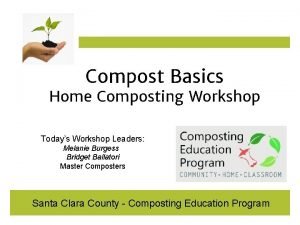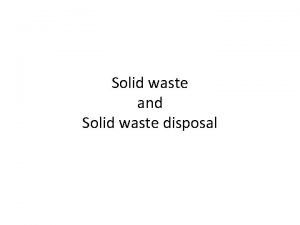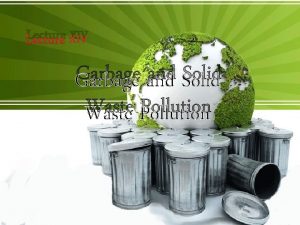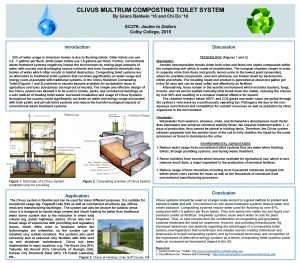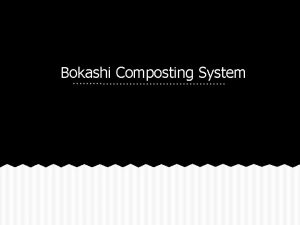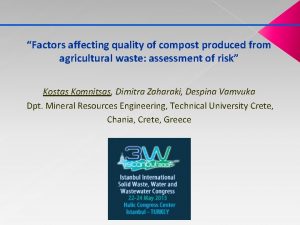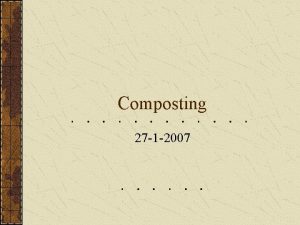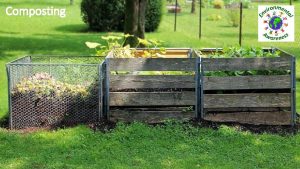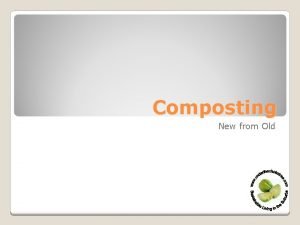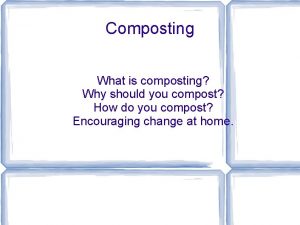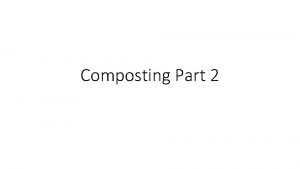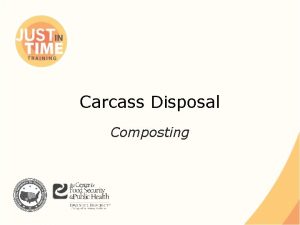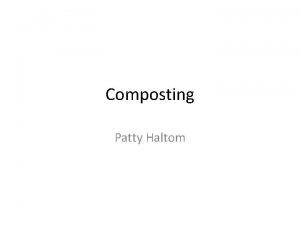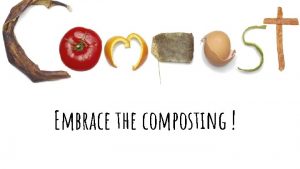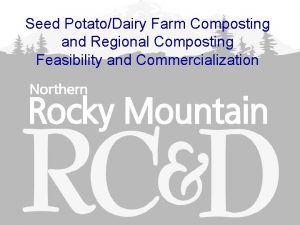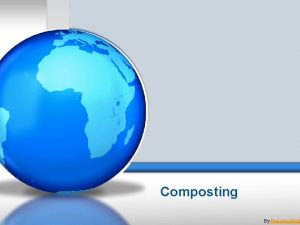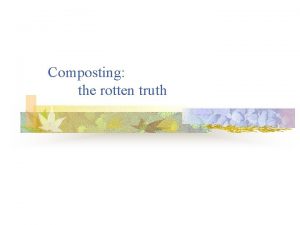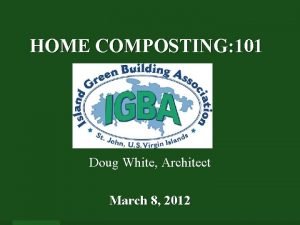GUIDE TO HOME COMPOSTING What is composting Composting

















- Slides: 17

GUIDE TO HOME COMPOSTING

What is composting? Composting is the speeding up of the natural process of decomposition of organic waste by organisms, such as fungi, bacteria and earthworms.

Why should I compost? There are two main reasons for composting. First, by composting most of your organic wastes, you will be reducing your household garbage by up to 30%. That more than the amount reduced by blue box recycling. Secondly, compost is very beneficial for your lawn and garden. It recycles the nutrients and organic matter in plants back to the soil, breaking up clay soil and adding slow release nutrients to any soil.

What can I compost? A general thumb is that anything that was once alive is compostable. However, there a few items which should be avoided. Meat and bones, for example, contain fats which are difficult to break down, may attract animals and can couse oddors. Some plants materials such as walnut leaves contain toxins that are growth inhibitors. Weeds can be composted as long as they have not yet produced seeds. Diseased plants are also best avoided in a compost file.

Do I need a container? A compost container is not necessary. You can make compost by just pilling up organic material in a corner of your yard. However, a container definitely improves the look of your compost pile. As well, a container discourages neighbourhood animals from digging at your pile, keeps the pile contained, and lets you control the amount of moisture and sun on the pile.

How di I make a compost pile? (1) The smaller the pieces, the faster they will compost. To have compost sooner, chop up whole pieces of fruit or vegetables, break up plant stalks. Shred leaves, chip woody materail and crush egg shells.

How di I make a compost pile? (2) Try to get a good mix of kitchen waste, leaves and grass clippings. The microorganisms in your pile work best on a balanced diet of carbon and nitrogen. Leaves are high in carbon and kitchen waste and grass clippings are high in nitrogen.

How di I make a compost pile? (3) A mix of wet and dry is best too. A pile that is too wet will smell and dry pile will work very slowly. The pile should be as moist as a squeezed out sponge. Alternate wet kitchen waste with dry leaves or dry grass clippings. Use a cover to keep the pile from becoming too wet from rainfall. Occasional watering may be required to moisten the pile of it becomes too dry.

How di I make a compost pile? (4) Turn the pile every 2 weeks. ‘Turning’ means digging down into the pile to mix the materials and introduce air into the pile. This is important to make sure the organisms doing the work have enough air to live and have access to uncomposted material.

How di I make a compost pile? (5) A container or pile that is one cubic yard or larger will provide the optimum composting conditions. Piles smaller than this may not heat up as well but will still work, just not as fast.

What is the best location for a compost pile? Choose a spot where there is good water drainage is very good, a shady spot is best so that the compost piles does not dry out. If the drainage is poor, a sunny spot is best. When choosing a site for your composter, you should also consider how far you will have to walk to add materials and the location of the garden, flowerbeds or wherever else you plan to use the finished compost. Resist the temptation to put the composter in the farthest corner of the yard.

Will it smell? A compost pile that is working well should not have an unpleasant odor. If it does, it may be that the material it too wet or compacted, and is not getting enough air. Too much wet grass is also a probable cause of odor from a compost pile. Turn the pile frequently to allow it to dry out a bit and to ensure that it is well aerated.

Will composting attract animal and files? Most animal will not be interested in your compost pile. To discourage animals and files, use a container with a secure cover, don’t add meat scraps or fat, and dig in food waste each time you add it, or cover it with soil. If you do get animals digging at your pile, line the sides and bottom of the container with heavy duty wire mesh.

How long will it take? This will vary. It the composting materials are finely shredded, kept well aerated, turned once a week and kept moist, useable compost can be produced in as little as 6 -8 weeks. For those who use a more relaxed approach, useable compost can be produced in less than a year. It is best to let the organic material compost as long as possible. If organic material that is still decomposing is added to the soil, it may compete with growing plants for any available nitrogen.

How do I know when the compost is finished? There are two ways to tell if your compost is finished. First, when the organisms in yor pile are still working on uncomposted material, they will generate a lot of heat. If you turn an active compost pile, a small amount of steam should rise or the inside of the pile should feel warm. When the compost is finished, the pile should not be all that warm. Second, is the look of the material. Don’t judge your pile by what it looks like on top. Underneath the newly added material is where all the compost activity is. After the couple of months of piling and turning, dig into the bottom of your pile. You’ll probably be surprised to find back, soil like materials. That’s compost. Ideal compost should be dark, crumbly and earth smelling. The identity of most the material should be lost.

How do I harvest finished compost? If your container has a door at the bottom, you may be able to get finished compost out that way. Otherwise, using a pitchfork or shovel, remove the uncomposted material from the top of the pile. Dig out of the black material from underneath. There may be uncomposted pieces in the finished compost. Put the compost through a sreen or hand pick out the uncomposted material. Put all the uncomposted material back into the compost container to start a new pile.

What am I going to do with all that compost? Firstly, you won’t have as much compost as you think. The volume of organic material will shrink by almost 80% during the composting process. There a multitude of uses for compost. Many gardeners empty any finished compost from their piles every fall to make room for adding material over the winter. The compost is then dug into flower and vegetable gardens. Compost can be used as a mulch, in place of peat moss. Screened compost can be spread on your lawn and then raked in, or used as a potting medium for houseplants or seeding. Make compost in your watering can. Use the tea to water your plants. If you really can’t use the compost, give it to a neighbor with a garden.
 Home composting
Home composting Takakura composting
Takakura composting Controlled tipping method
Controlled tipping method Disadvantages of composting
Disadvantages of composting Wicler
Wicler Clivus multrum composting toilet
Clivus multrum composting toilet Bokashi composting toilet
Bokashi composting toilet Factors affecting composting
Factors affecting composting Oak springs rv park
Oak springs rv park South carolina mobile home parks for sale
South carolina mobile home parks for sale Jr rabbin imam pretre
Jr rabbin imam pretre Let's go to my house let's go today
Let's go to my house let's go today Plural of flower
Plural of flower She said that, home economics stands for the ideal home.
She said that, home economics stands for the ideal home. Lagi
Lagi Come home come home jesus is calling
Come home come home jesus is calling Home sweet home survive prayer
Home sweet home survive prayer Perbedaan home care dan home visit
Perbedaan home care dan home visit
